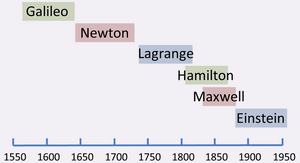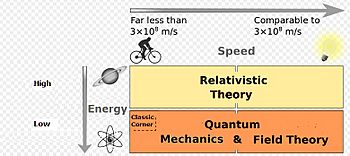Classical physics facts for kids
Classical physics is a big part of physics. It includes older ideas and rules about how the world works. These ideas were developed before some of the newer, more complex theories came along. We often use classical physics when the newer theories are too complicated for what we need to understand.
Contents
What is Classical Physics?
Classical physics has a few different meanings depending on what part of physics you are studying.
Classical vs. Quantum Physics
When we talk about quantum mechanics, classical physics means ideas that don't use the concept of "quantization." Quantization is about things like energy existing in tiny, specific packets, not in a smooth, continuous way. So, classical physics includes:
- Classical mechanics (how things move and interact).
- Relativity (how space, time, and gravity work).
Also, classical field theories, like general relativity (gravity) and classical electromagnetism (electricity and magnetism), don't use quantum mechanics.
Classical vs. Relativistic Physics
When we talk about special relativity and general relativity, classical physics usually means ideas that follow "Galilean relativity." This is an older idea about how motion looks the same from different moving viewpoints, as long as they are moving at a steady speed.
Main Areas of Classical Physics
Classical physics covers many exciting topics that help us understand the world around us. Here are some of the main areas:
- Mechanics: This is about how things move and why. It explains how levers help lift heavy objects, or why a car keeps moving for a bit after you turn off the engine.
- Thermodynamics: This area deals with heat and temperature. It helps us understand why some things feel hot and others cold. It also explains why it takes longer to heat water than air.
- Electricity: This is about electric charges and currents. It explains why rubbing a balloon on your hair can make it stick to a wall. It also tells us why lightning can travel huge distances.
- Magnetism: This area explores magnets and magnetic fields. It explains why a compass needle always points north. It also shows how you can make a temporary magnet by wrapping wire around a nail and running electricity through it.
- Optics: This is the study of light. It helps us understand why sunlight passing through raindrops makes a rainbow. It also explains how lenses can make things look bigger or how telescopes work.
Some specific theories that are part of classical physics include:
- Classical mechanics
- Newton's laws of motion
- Classical Lagrangian and Hamiltonian physics
- Classical electrodynamics (Maxwell's equations)
- Classical thermodynamics
- Special relativity and general relativity
- Classical chaos theory and nonlinear dynamics
Classical Physics vs. Modern Physics
The term "modern physics" is a bit broader. It can mean just quantum physics or all of the physics developed in the 20th and 21st centuries. Modern physics includes quantum theory and relativity, which are often needed for very small things (like atoms) or very fast things (like light).
We can use classical physics to describe a physical system if its conditions allow for it. This means that the rules of classical physics work well enough. For example, objects bigger than atoms and molecules, and even huge objects in space, can usually be understood very well using classical physics.
Computers and Classical Physics
Today, computers can solve complex classical physics problems in seconds. They perform millions of calculations very quickly. In the past, scientists like Isaac Newton, who helped create calculus, would spend hours solving the same equations by hand. This shows how much technology has changed the way we study physics!
See also
 In Spanish: Física clásica para niños
In Spanish: Física clásica para niños



